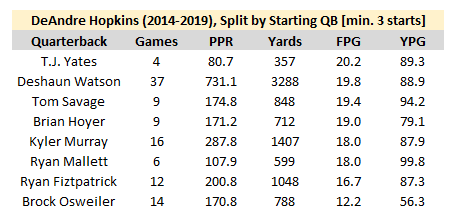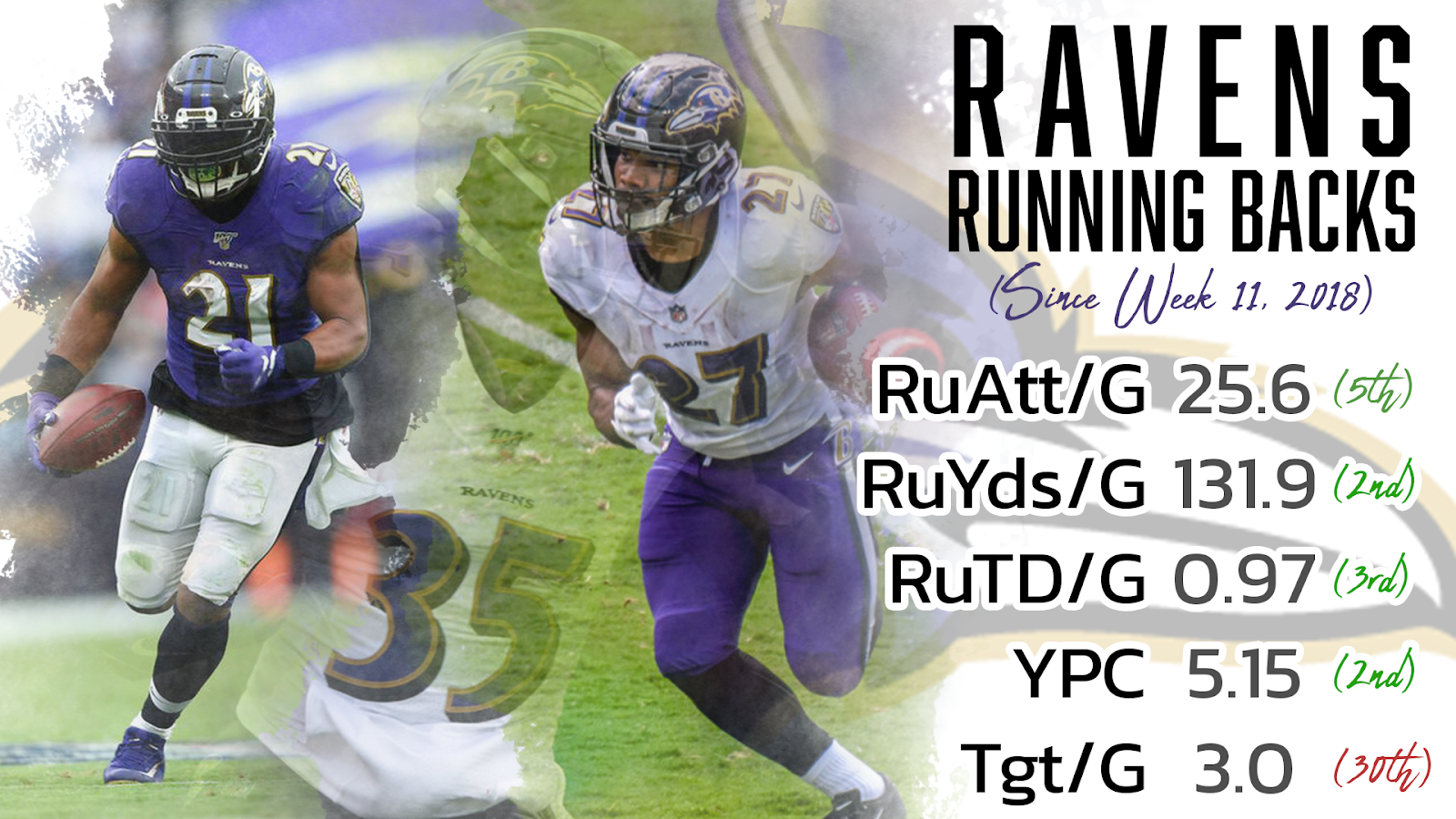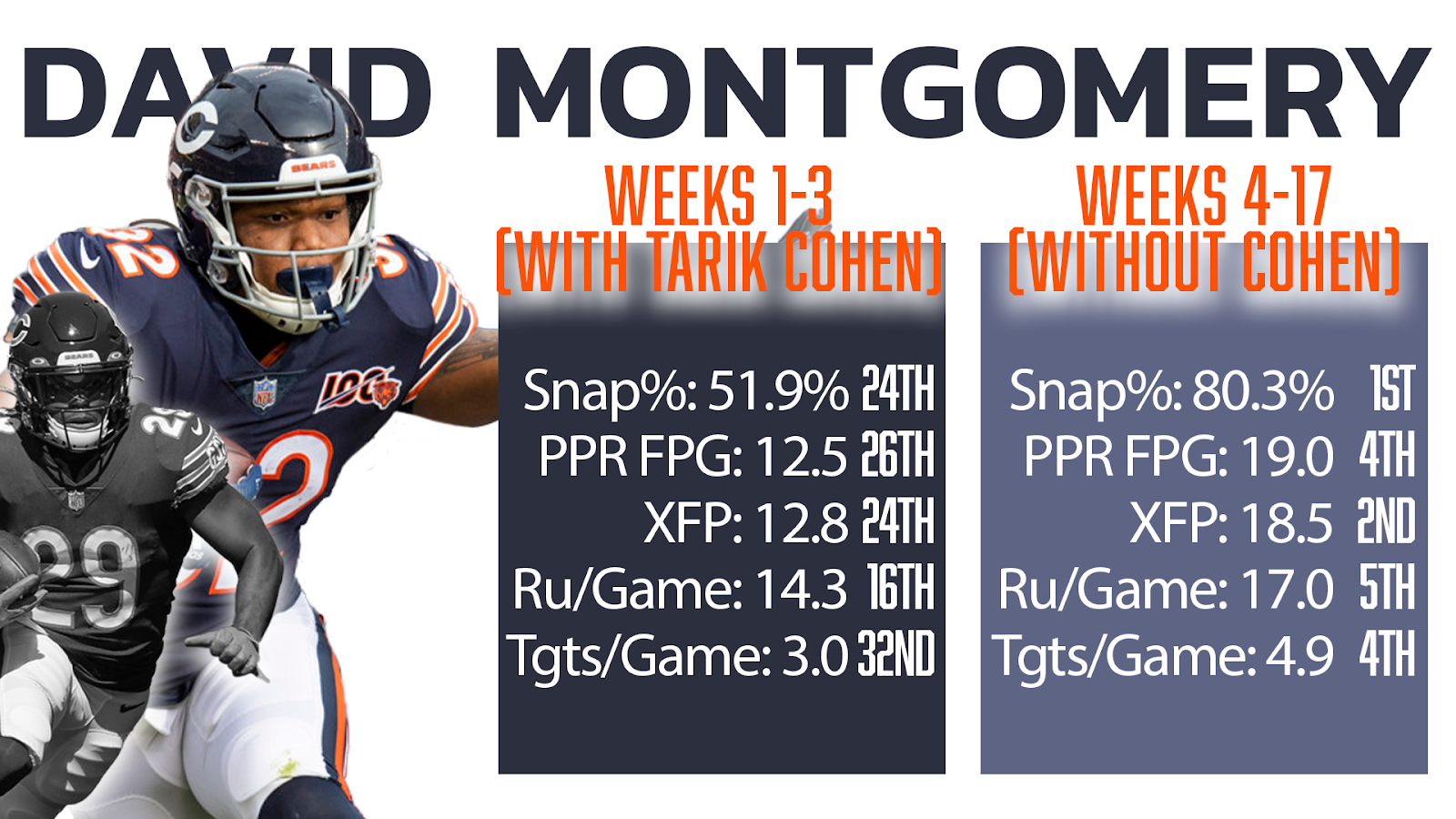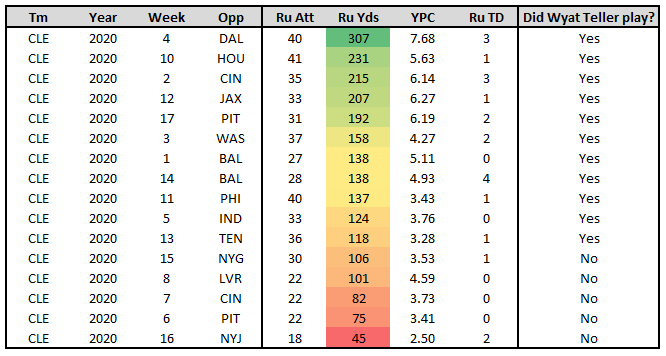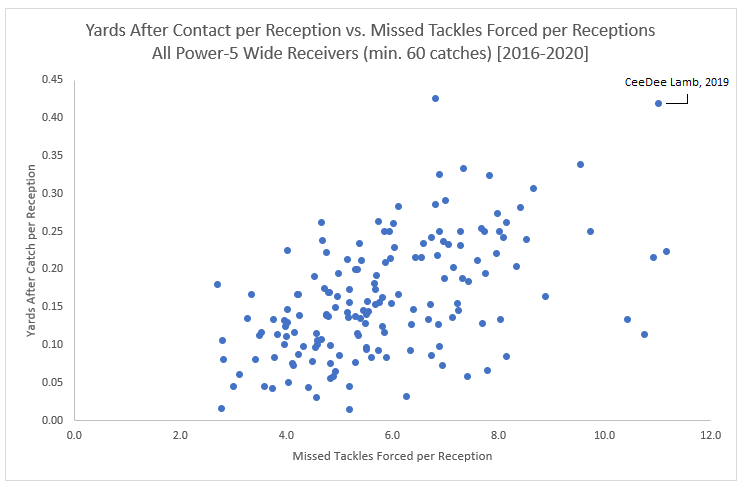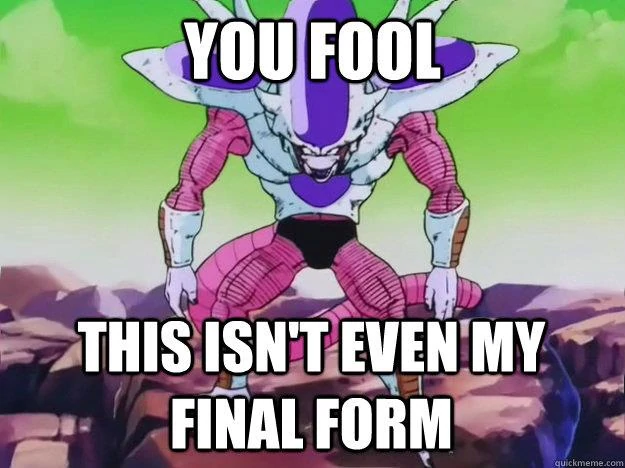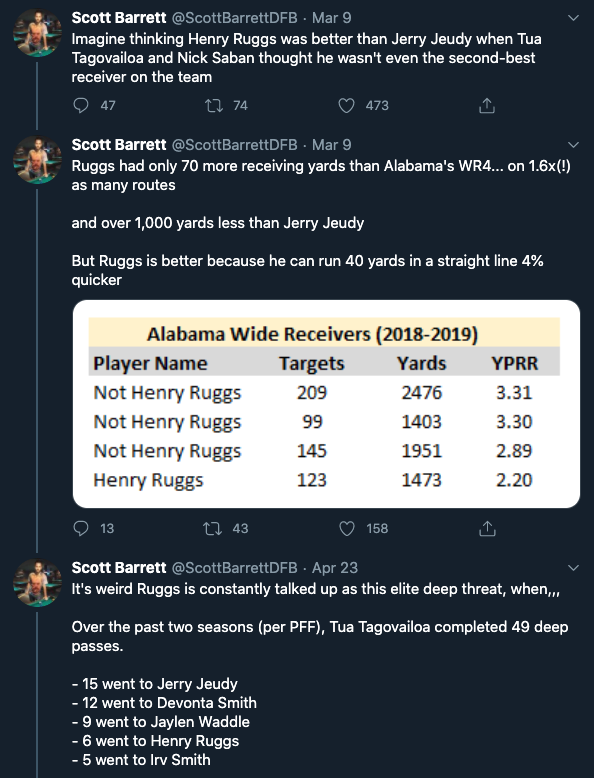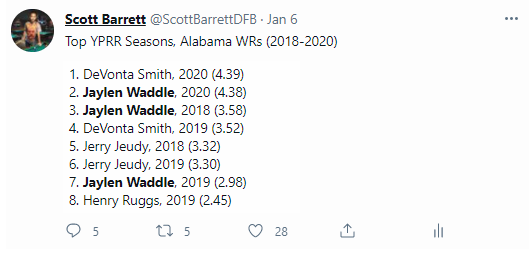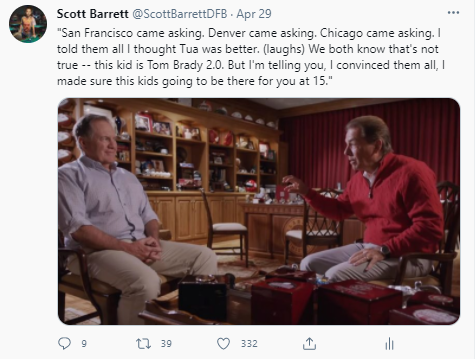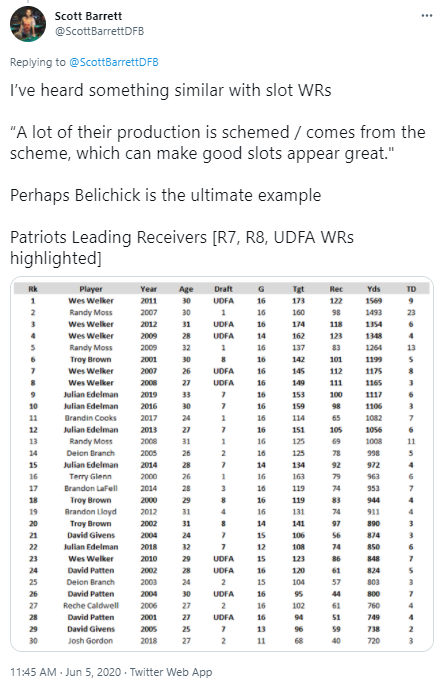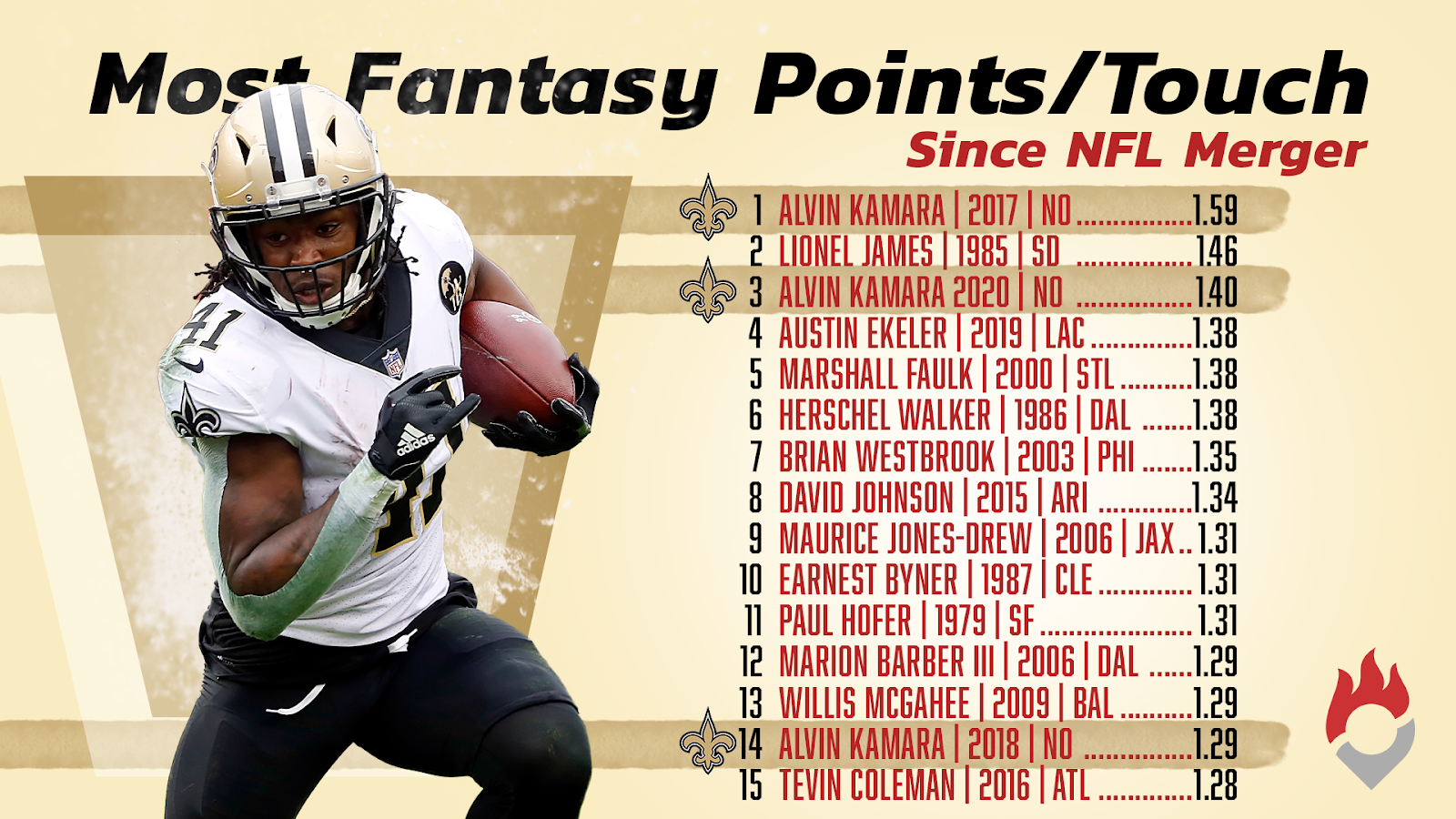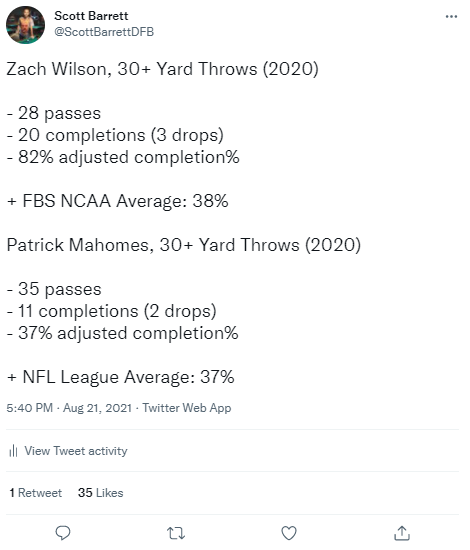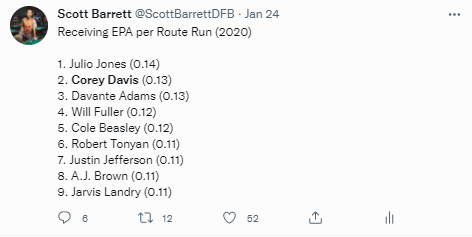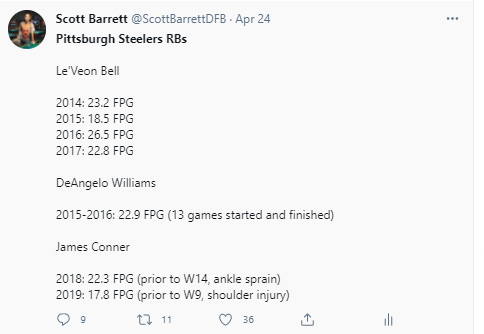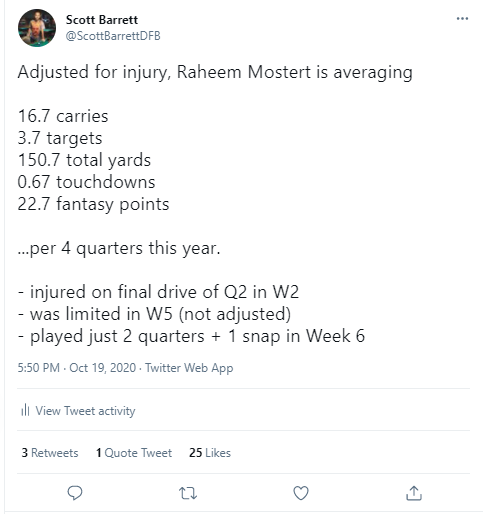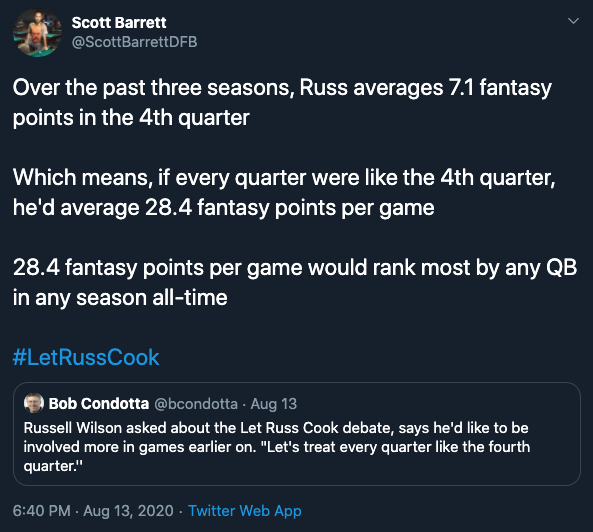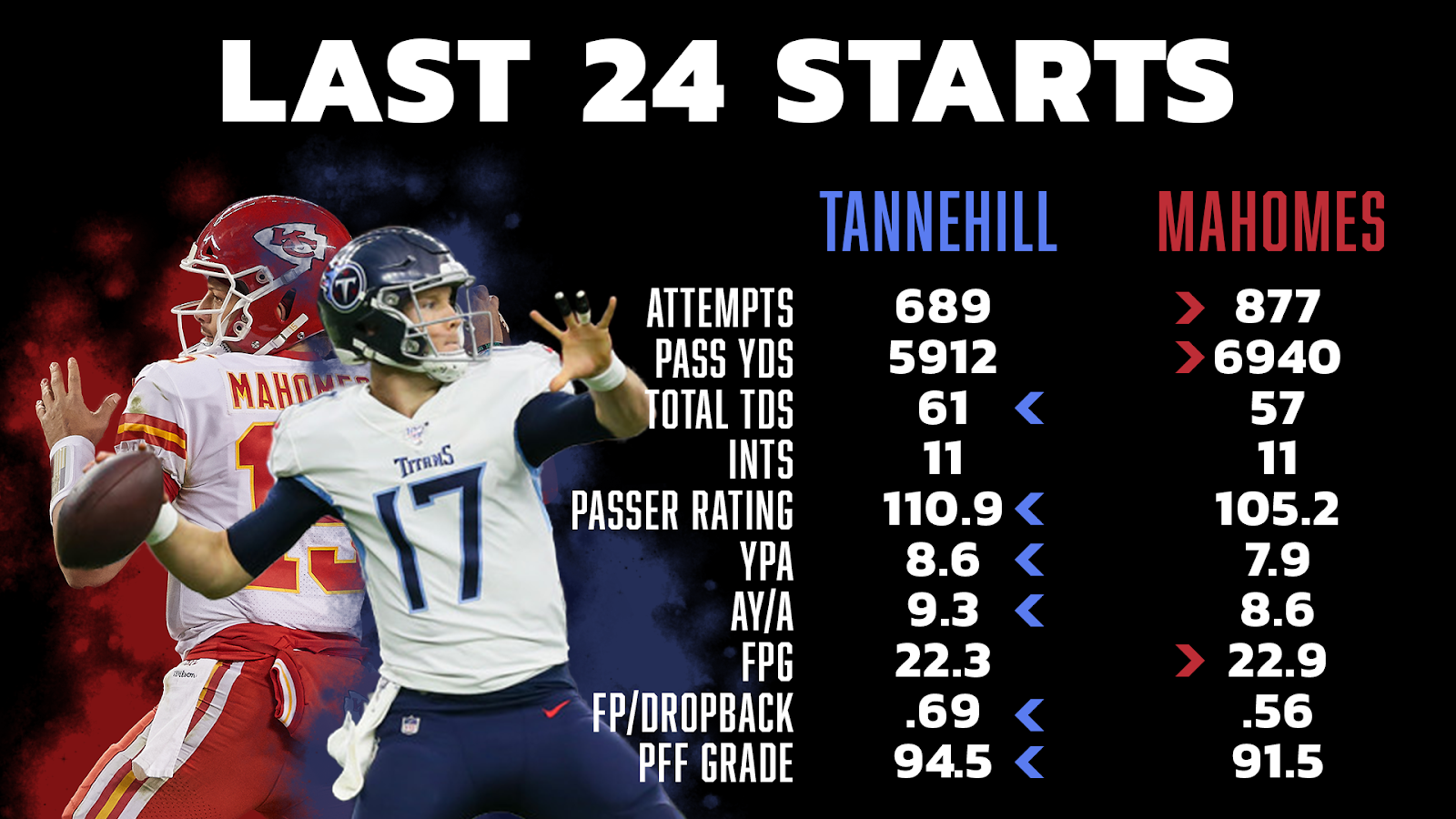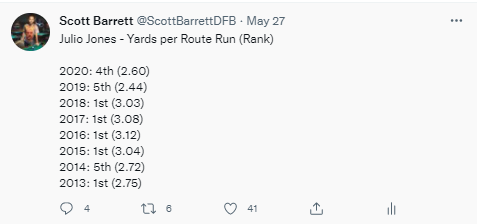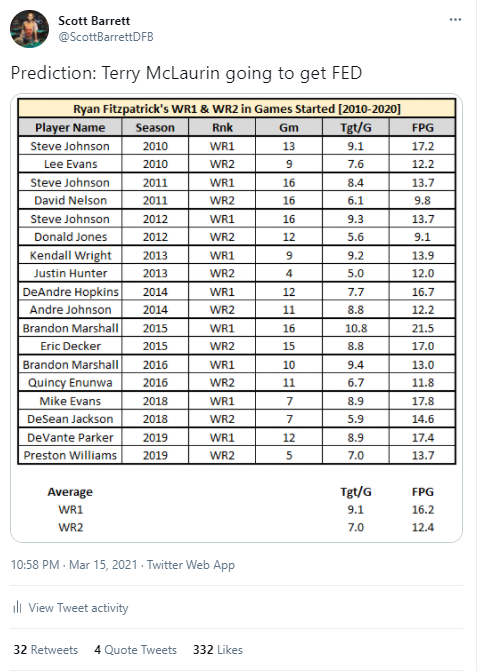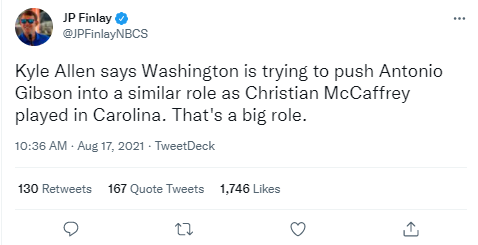Bear with me as I do my best possible Matthew Berry impression. I’m well aware this little intro is a “ripoff…” but I’ll explain in a bit.
Running Back A: Last season, “Running Back A” ranked top-15 of 47-qualifying running backs in yards per carry average (4.70). This was a career-high. He also ranked top-5 of 41-qualifying running backs in yards per target average (6.8). This was not a career-high. Unbelievably, he’s eclipsed that mark three other times. If excluding just one game last year, when this player exited in the first quarter due to injury, “Running Back A” would have finished: first in Snap% (81%), 12th in yards from scrimmage per game (89.9), 12th in fantasy points per game (16.2), and 12th in expected fantasy points per game (16.0). And he was unstoppable to close out the season, hitting at least 21.0 fantasy points in each of his last three games (averaging 24.7 FPG).
Running Back B: While “Running Back A” hit 21.0 fantasy points in each of his last three games, “Running Back B” has reached that mark only three times over the past two seasons. Among all running backs with at least 100 carries last year, “Running Back B” ranked 6th-worst of 47 qualifying running backs in yards per carry average (3.60), sandwiched in between the corpses of Adrian Peterson (3.87) and Frank Gore (3.49). He was also less efficient than “Running Back A” through the air, ranking 31st of 49-qualifying running backs in yards per target average (5.31). And he’s long been an inefficient player for fantasy — he’s fallen short of his weighted opportunity-based expectation by 1.0 or more FPG in three of the last four seasons. While gamescript shouldn’t be an issue with “Running Back A” — he was a true bell cow, and hyper-productive despite his team’s 4-12 record — gamescript has long been an issue for “Running Back B.” Over the past two seasons, “Running Back B” averages just 12.6 FPG in games his team lost. Vegas set his team’s over/under at just 6.5 wins, so you’re looking at — what? — no better than mid-range RB3-levels of production over 60% of the time?
Both running backs are still with their same team. Whom am I talking about? Whom would you rather have?
Would it help if I told you “Running Back A” is being drafted as the RB45… and “Running Back B” is being drafted in Round 2?
“Running Back A” is David Johnson, a player you couldn’t pay me to draft. “Running Back B” is one of my favorite and most-drafted players this year, Joe Mixon.
“Lies, damned lies, and statistics.”
Clearly, if you can make David Johnson look better than Joe Mixon, you can use statistics to craft any sort of narrative you want.
But that’s not strictly limited to statistics. You can make a compelling argument for just about any ridiculous thing in the world so long as you frame it in the right way. And such sophistry is dangerous, not only to others but especially to yourself.
For instance, you can convince yourself that the cute girl from your chemistry class is way out of your league and she’d pillorize you if you dared to ask her out to prom. You imagine the Principal announcing it over the P.A. system, “OMG! Did you guys hear? Jason actually thought he had a chance with Stacy. What a moron!” and then the entire school including the janitors and lunch ladies erupt into hysterical laughter lasting no doubt several hours at least. But none of this is true. Stacy’s been hoping you’d ask her for weeks now, patiently waiting for you to overcome your paralysis by overanalysis. This was just a false narrative you’ve sold yourself, one you’ve let keep you from realizing a greater potential reality.
Don’t be like Jason. Don’t let fear corrupt reason. Be watchful and diligent, pay special attention to the stories you’re telling yourself. Ask yourself, “How real is this?” Or are you, in a manner of speaking, just trying to make David Johnson look better than Joe Mixon?
I remember many years ago, during a very weird time of my life, being stuck in a sort of rut. Being stuck, essentially, living 24/7 rent-free in my own head, which was constantly working on overdrive but not at all in any way that was actually constructive or beneficial to me.
I remember, during the worst of this, reaching out to my friend Eddi. A friend I’ve always viewed, not quite as a mentor, but as the sort of Hesh Rabkin to my Tony Soprano. Basically, I value his opinion more than any of my other friends. I always come to him first when seeking counsel, and he’s never once failed me in giving great advice — usually, exactly the thing I needed to hear at that exact point in time.
If you asked Tom Brady or Russell Wilson what separates them from every other quarterback in the league. They’re not going to say “arm strength”, “vision”, “intelligence”, or maybe even “work ethic.” They’re going to say, and have said [1, 2, 3, 4], the determining factor is their “mindset.”
Eddi is smart, but not the smartest person I know. What separates him from all of my other friends is his unshakeable, impeccable mindset. A mindset that’s carried him through and allowed him to overcome some of the bleakest tragedies a person can endure. After venting to him about my troubles, Eddi recognized my problem immediately. He told me, “You have a rare analytical ability.” (He said this well before I started working in this industry, putting those skills to good use.) “You have a rare analytical ability. But that ability can be both a gift and a curse.”
This quote, the longer conversation, and Eddi’s mindset to emulate helped lead to a profound and irrevocable change in me. I consciously corrected my mindset, and I worked hard to ensure my overly analytical mind was always working for my benefit rather than against me. I started to see the world and my potential through an entirely different — albeit somewhat woo-woo — lens.
One of the key realizations was that our beliefs are immensely powerful and have a real and profound impact on our reality. As far as I’m concerned it’s the closest thing to magic that exists in this world. And downstream from that, the effects produced from things like placebos and nocebos, positive thinking, positive affirmations/visualization, and hypnosis/hypnotic suggestion all seem weirdly magical to me.
Hypnosis/Hypnotic Suggestion: “Montgomery et al.’s review (2000) of 18 articles and 27 effect sizes, based on the pain reports of 933 participants, revealed that hypnotic suggestions relieve pain for 75% of the population, across different types of experienced pain.” [5] Hypnosis has even been used as an effective (98%) replacement for general anesthesia during certain kinds of breast cancer surgery. [6]
Positive Affirmations/Visualization: “Student-athletes were asked to positively visualize themselves performing lifts that they physically executed frequently in their training regimen (bench-press, back squat, clean or deadlift)… The positively visualizing group demonstrated a 10-15 lb. increase in weight moved, while the control group only demonstrated a 5 lb. increase.” [7] Another study showed similar improvements in strength between one group of volunteers who only visualized themselves engaging in the exercise of a muscle (+35%), versus a group who was actually exercising that specific muscle (+53%). Again, the first group saw similar strength gains despite never actually engaging in exercise (only visualizing the act of exercise). [8]
Positive Thinking: Studies have shown that both on- [9] and off the field, our expectations will often predict our outcomes. Or at least the effect is meaningfully correlated. "Several studies indicate that patients' presurgical expectations can influence postsurgical health outcomes." [10] From another study, “Our results further suggest that optimism is specifically related to 11 to 15% longer life span, on average, and to greater odds of achieving ‘exceptional longevity,’ that is, living to the age of 85 or beyond.” [11]
The Placebo & Nocebo Effect: In one study from Japan, 13 teenage boys were blindfolded and had their arms rubbed with leaves. On one arm they were rubbed with the leaves of the Japanese wax tree (Japan’s equivalent to poison ivy or poison sumac) but were told these were actually just the leaves of a chestnut tree, and thus harmless. All 13 boys had a history of high sensitivity to the urushiol-containing leaves of the wax tree. But only two subjects developed a reaction. On the other arm, they were treated with leaves from the inert placebo-like chestnut tree but were told these were the leaves of the poison ivy-like wax tree. From the placebo, all 13 subjects developed allergic contact dermatitis (symptoms include: rashing, redness, pain and discomfort, itching, hives or blisters, swelling, etc.). [12]
In any case, I’m reminded of this all today, because, seriously, if you can make a compelling argument that David Johnson is a better pick than Joe Mixon, you can make a compelling argument for almost anything. And when you make a compelling argument, you run the risk of believing it. And if you believe it, you will (I truly, unironically, believe) more readily will it into existence. That could mean realizing all of your worst fears or all of your wildest dreams. Or at least, as our last example showed, developing oozing blisters on your arm only because you falsely believed you came in contact with poison ivy.
So why not believe — actually choose to believe — always in the best possible outcome. Believe you are impeccably healthy, or that you will be soon. Believe you will live to see your 110th birthday (24.5 in Gore years). Believe you will be unfathomably wealthy. Believe that you will dominate your fantasy football league for many years to come.
That’s what I did shortly after my conversation with Eddi eight years ago. I had no right to believe I would ever work full-time as a fantasy expert. I had as many fantasy articles written as articles rejected by my editor (three), and the ones that were published weren’t read by anyone, and thankfully so, as they weren’t any good. But I wanted it more than anything. And, more importantly, I believed not only that it was possible, but that it was an inevitability.
In each of the past 12 years, my favorite fantasy football article every offseason has been Matthew Berry’s “100 Facts For The Fantasy Season” on ESPN. Every year, even still, I anxiously await its release. (The 2021 edition was released last week, here.)
Eight years ago, around the time I had that talk with Eddi, I was a bartender. The restaurant had closed for the night — it was between two and three in the morning. We were supposed to be cleaning up and prepping for the bartenders working the lunch shift. I was nowhere to be found. My boss and co-workers were furious.
Unbeknownst to them, I was sitting on a milk crate, shivering in a walk-in refrigerator. A league-mate had just texted me that Berry’s article had dropped and started sending me his favorite stats from the article. I dropped everything, trying to go over all 4,000 words/100 facts as quickly as possible. My sole source of income could wait — there were stats to devour.
Fast forward to today, and I no longer have to hide in refrigerators to do fantasy-related research. Now, I work full-time at FantasyPoints to do just that. Or, as my friends say, “He gets paid to sit at home in his underwear and tweet about fantasy football.”
My dream became a reality because I believed it. I had no right to believe it. My odds were worse than David Johnson outscoring Joe Mixon this year. And yet, here we are.
Or, should I say, here I am — in my boxers, writing this article, shamelessly ripping off my all-time favorite article, Berry’s most prominent article. (With his permission of course. Thanks Matthew!)
This is 96 Stats.
32 teams. 3 stats each. 96 of my absolute and unfettered dankest stats possible.
But, of course, some of these statistics are only “very interesting” or “very dank” and not entirely meaningful. To see where I really stand on each player, you’re going to have to read this article — My Guys.
Arizona Cardinals
1A. Kyler Murray ended the fantasy season (Weeks 1-16) as the overall QB1, averaging 25.8 FPG. That ranks 6th-best by any QB in any season all-time. His 9.8 FPG on the ground ranks 4th-most by any QB in any season since 1975.
1B. But his numbers look even more impressive if we adjust for a shoulder injury suffered in Week 9.
1C. After the injury, Murray averaged just 18.8 FPG and 5.7 rushing FPG.
1D. Before the injury (Weeks 1-9), Murray averaged 30.1 FPG and 12.8 rushing FPG.
1E. For perspective, both early-season marks would be NFL records, easily beating Lamar Jackson’s 27.7 FPG and 10.8 rushing FPG, both set in 2019.
1F. On average, he’s being drafted two full rounds behind Patrick Mahomes.
2A. Might Rondale Moore be a Wes Welker-esque PPR cheat code at the NFL level? Perhaps something akin to a Kryptonian Cole Beasley? I think so. Moore is a very special prospect, who…
2B. … averaged 8.90 career receptions per game at Purdue. That ranks 2nd-best by any wide receiver since at least 2000, behind only Davante Adams (8.96).
2C. Moore was heavily involved this preseason (and working as a starter), earning 9 targets and 3 carries through four quarters of play.
3. Only five WRs averaged 18.0 or more FPG last year. DeAndre Hopkins has accomplished that feat with six different quarterbacks throughout his career.
Atlanta Falcons
1A. Excluding a Week 4 game Calvin Ridley left early due to injury, he’s reached at least 90 yards or scored a touchdown in 16 of his last 18 games (89%). And he's reached at least 17.0 DK fantasy points in 15 of those 18 games (83%). Contrast this with Keenan Allen, who hit that mark in just eight of his last 18 games (44%).
1B. Julio Jones has missed eight games over the past two seasons.
1C. Calvin Ridley saw at least 9 targets in each of those eight games (though he fell below that mark 65% of the time when Jones played), and only once failed to reach at least 17.0 fantasy points.
1D. Across those eight games, Ridley averages 11.1 targets, 107.0 receiving yards, and 21.9 DK FPG. For perspective, those numbers would have ranked best, best, and 3rd-best (respectively) last season.
2A. Last season, Mike Davis ranked 3rd-best of 63-qualifying running backs in PFF’s Elusive Rating.
2B. Per SIS, only three players ranked top-10 in avoided tackle rate on both rushing attempts and receptions: Alvin Kamara, David Montgomery, and Davis.
2C. The only other RBs on the team are former WR Cordarrelle Patterson and journeyman Wayne Gallman, whom the 49ers cut just days ago.
3A. Only five TEs saw 100 or more targets last season, and only two TEs eclipsed 800 receiving yards. Delanie Walker hit both marks in four straight seasons with current Falcons HC Arthur Smith as his TE coach (2014-2017).
3B. PFF awarded rookie TE Kyle Pitts with a 97.0 overall grade in 2020, the highest grade they’ve ever awarded to a college TE.
3D. Pitts also set the PFF record for yards per route run by a TE, averaging 3.26 YPRR in 2020.
3E. Pitts — who has still yet to reach legal drinking age — averaged 96.3 YPG in 2020, giving him the best age-adjusted season by any Power-5 TE since at least 2000.
3F. He’s also the 2nd-most athletic TE since at least 2000, and probably of all time.
3G. Kyle Pitts will be in the Hall of Fame. He’s, by my measurements, the greatest TE prospect ever. And he just fell into an ideal landing spot.
Baltimore Ravens
1A. In 37 career starts, Lamar Jackson averages 74.8 rushing yards per game and 10.4 rushing FPG.
1B. In 31 career starts, Saquon Barkley averages 75.6 rushing yards per game and 10.9 rushing FPG.
1C. Over the past two seasons, Jackson leads all QBs in total FPG (25.5) and rushing FPG (10.2)
1D. Over this span, he averages the same passing FPG as Derek Carr (15.1).
1E. So, yeah, basically, Lamar Jackson is like if Derek Carr had Saquon Barkley’s legs. From a fantasy perspective, at least, it’s almost exactly that if you throw out what Barkley brings as a receiver.
2A. It is well known that a hyper-mobile QB is a cheat code for fantasy. But it’s also a cheat code for that team’s running backs (in terms of ground-game efficiency.) [Both points explained in more detail here.]
2B. In 22 career starts for Lamar Jackson, Baltimore's RBs averaged 5.15 YPC.
2C. Gus Edwards averages 5.23 YPC on 399 carries. Mark Ingram averaged 4.80 YPC on 274 carries. J.K. Dobbins averaged a league-high 6.01 YPC last year (as expected). For perspective, Nick Chubb averages a league-high 5.25 YPC over the past two seasons.
2D. Last season, Baltimore’s RBs combined to average 18.1 rushing FPG. If we assume Gus Edwards gets 75% of that with zero receptions, that would have been good enough to finish 4th among RBs in standard leagues last year.
3A. Marquise Brown averaged just 8.7 FPG across the first 10 games of the season last year.
3B. But he averaged 16.0 FPG across his final eight games (postseason included), clearing 80 yards receiving or scoring a touchdown in all eight. For perspective 16.0 FPG would have ranked 15th-best if over the full season, just behind Allen Robinson and Julio Jones.
Buffalo Bills
1A. Last season, Lamar Jackson gave you just 60% of Patrick Mahomes’ passing production. And Mahomes gave you just 30% of Jackson’s rushing production. But Josh Allen was 90% Mahomes as a passer (20.0 FPG) and 50% Jackson as a runner (5.6 FPG).
1B. In other words, he led the position in fantasy points scored with 405.7 (the 4th-most by any QB all-time).
2A. In each of the past three seasons Buffalo has ranked bottom-3 in team fantasy points scored at the RB position.
2B. Although a hyper-mobile QB might help boost a RB’s YPC, they rarely target their running backs. And can also cannibalize rushing upside with touchdown vultures.
2C. Buffalo’s RBs total just 179 receptions over the past three seasons, which ranks above only four other teams.
2D. Allen has 25 rushing touchdowns since entering the league, while the closest Buffalo RB has only 4 rushing touchdowns over the same span.
3. Including the postseason, Stefon Diggs averaged 11.2 targets, 109.6 receiving yards, and 25.5 DK fantasy points per four quarters (adjusting for the one game he left early) over his final 11 games. For perspective, those numbers would have ranked best, best (7th-best since 1970), and 2nd-best (9th-best all-time) if over the full season in each of the last three seasons.
Carolina Panthers
1A. Aaron Jones finished as a top-6 fantasy running back in just three games last year. Nick Chubb just twice. Austin Ekeler only once. Okay, so keep that in mind.
1B. Over his last 17 games, Christian McCaffrey has finished top-2 47% of the time, top-4 67% of the time, top-6 82% of the time, and top-8 94% of the time. So, just once he failed to finish top-8 (when he finished 14th).
Sam Darnold's Most Targeted Receiver
— Scott Barrett (@ScottBarrettDFB) May 6, 2021
2017: Deontay Burnett, 27.5% target share
2018: Quincy Enunwa, 21.7%
2019: Jamison Crowder, 26.1%
2020: Jamison Crowder, 25.3%
2020 (w/ Crowder out): Braxton Berrios, 27.5%
In each instance, Darnold's favorite receiver was the team's slot WR
2A. Dating all the way back to his time at USC (2017), Sam Darnold’s favorite receiver has always been his team’s starting slot wide receiver.
2B. This preseason, Darnold targeted the slot on 52% of his throws (2nd-most of 80 qualifying QBs).
2B. Based on preseason usage, rookie Terrace Marshall is most likely to be the team’s starting slot WR. He’s run 67% of his routes from the slot, well above Robby Anderson (33%) and D.J. Moore (19%). 2D. Marshall is a near-elite athlete (90.2 SPORQ) who posted a 37% yardage share and an absurd 63% touchdown share when active for LSU last year.
2E. This preseason, Marshall turned 12 targets into 9 catches for 181 yards and a score. He finished top-6 of 184-qualifying WRs in both fantasy points per route run and PFF receiving grade.
2F. Last year Carolina supported three starter-worthy WRs — Anderson, Moore, and Curtis Samuel, who all finished top-25 at the position.
2G. Despite the fact that Moore was out-scored by both Anderson and Samuel last year, he leads the current trio by ADP. He ranks 20th. Anderson ranks 29th.
2H. Marshall ranks 60th.
3A. Since entering the NFL, Sam Darnold ranks 33rd of 33 qualifying QBs in PFF pass grade and 41st of 41 QBs by ANY/A.
3B. Last season he averaged 12.1 fantasy points per start, which ranked 33rd of 33 qualifying QBs.
3C. But if Adam Gase-adjusted, that’s equivalent to like 29.6 fantasy points per start. Right?
Ryan Tannehill
— Scott Barrett (@ScottBarrettDFB) October 14, 2020
w/ Adam Gase: 89.0 passer rating
w/out Gase: 115.4 (leads NFL)
Robby Anderson
w/ Gase: 10.1 PPR/G (55th)
in 2020: 18.2 PPR/G (WR1)
DeVante Parker
w/ Gase: 8.1 PPR/G
w/out Gase: 15.1 (WR1)
Le'Veon Bell
w/ Gase: 13.5 PPR/G
w/out Gase: 21.9 (most ever)
Chicago Bears
1A. Something interesting happened over David Montgomery’s final six games. He averaged a McCaffrey-like 25.7 FPG over this span, but just 12.5 FPG up that point (Week 12).
1B. Five of the six highest-scoring games of his career came over this six game-stretch.
1C. What caused this? There were a number of factors at play here.
1D. For one thing, the Tarik Cohen injury was massive.
1E. For another, former All-Pro Cody Whitehair moved from C to LG in Week 12, and Matt Nagy handed off play-calling duties to Bill Lazor in Week 10.
1F. Cohen is on the PUP list and, thus, out for at least the team’s first six games. And Whitehair will remain at LG in 2021. But Nagy (unfortunately) will resume play-calling duties.
2020 Chicago Bears
— Scott Barrett (@ScottBarrettDFB) April 2, 2021
Matt Nagy calling plays: 19.8 points per game
Bill Lazor calling plays: 27.7 points per game
David Montgomery (2020)
Matt Nagy calling plays: 12.3 fantasy points per game
Bill Lazor calling plays: 25.7 fantasy points per game https://t.co/TW07Ft2U1W
1F. Another factor might just be random variance — in other words, “splits happen.”
1G. But, I think, maybe the most significant factor was his pillow-soft strength of schedule. Montgomery had a difficult schedule to start the season (-0.44), but the league's softest schedule from Week 12 on (worth in real terms a boost of about +4.35 fantasy points to his per game average).
1H. Still, his schedule is soft once again, and he ranks just 15th by ADP after finishing as the overall RB4 last year.
2. Allen Robinson may finally see targets from a competent quarterback!
Allen Robinson, Career Targets
— Scott Barrett (@ScottBarrettDFB) January 11, 2021
Blake Bortles - 372
Mitch Trubisky - 301
Nick Foles - 69
Chase Daniel - 29
Chad Henne - 11
Tyler Bray - 1
Bryan Walters - 1
3A. Justin Fields has massive Konami Code-upside. He averaged 10.2 rushing FPG and 64.6 rushing YPG in 2020, after averaging 9.2 and 49.1 in 2019.
3B. Fields’ 4.46 40-yard-dash ranks 4th-best of 372-qualifying QBs since 2000, behind only Robert Griffin III (4.33), Michael Vick (4.33), and Reggie McNeal (4.40). At 227 pounds, Fields’ Speed Score of 114.74 ranks 3rd-best, behind only Griffin (126.9) and Vick (119.5), and just ahead of Cam Newton (114.72) and Vince Young (113.7).
3C. This preseason, he’s averaged 22.8 fantasy points and 10.1 rushing fantasy per four quarters.
Cincinnati Bengals
1A. According to my model, Ja’Marr Chase ranks as the best WR prospect to come out since at least 2015. (And that was before a 98th-percentile showing at his Pro Day.)
1B. In 2019, Chase totaled 1,780 yards (the 6th-most by any Power-5 WR since at least 2000) and 20 touchdowns (the 5th-most by any Power-5 WR since at least 2000).
1C. That’s impressive enough, but this was also 240 yards and 2 touchdowns more than teammate Justin Jefferson, and on 13 fewer targets. Yes, the same, Justin Jefferson who totaled 1,400 yards in 2020; the most by any rookie WR since the NFL merger in 1970.
1D. And better yet, Chase did this when he was only 19 years old, nearly a full year younger than Jefferson.
1E. After adjusting for age, Chase’s 2019 season rivals only Michael Crabtree’s 2007 season as the best by any Power-5 WR since at least 2000.
1F. And now he’s paired back up with the same QB he had in 2019.
Best Age-Adjusted WR Seasons by Total Receiving Yards
— Scott Barrett (@ScottBarrettDFB) March 26, 2021
+ Power-5 WRs Only, Since 2000
1. Michael Crabtree, 2007
2. Ja'Marr Chase, 2019
3. Brandin Cooks, 2013
4. Justin Blackmon, 2010
5. Amari Cooper, 2014
6. Larry Fitzgerald, 2003
7. Devonta Smith, 2020
2A. Last season, Joe Mixon averaged 19.8 carries, 4.3 targets, 16.9 fantasy points, and 19.2 XFP per game. Those numbers ranked 3rd-, 13th-, 8th-, and 2nd-best over the full season.
2B. And now Giovani Bernard is gone. And OC Brian Callahan told us in May: “I don’t want Joe to leave the field, personally, and I think he’s up to that challenge … Joe shouldn’t come off the field, he should be on the field every down. He’s aware of that.”
2C. What’s his upside? It’s sky-high. Heck, what’s his floor? It’s sky-high. Both well above his ADP (RB13).
Weighted Opportunity Points per Game (2018-2020)
— Scott Barrett (@ScottBarrettDFB) July 27, 2021
1. C. McCaffrey (23.4)
2. S. Barkley (20.7)
3. E. Elliott (19.9)
4. A. Kamara (19.8)
5. D. Cook (17.7)
...
8. J. Mixon (16.1)
...
47. G. Bernard (8.7)
Give Mixon __% of Bernard and he's...
80% = Barkley
50% = Zeke
20% = Dalvin
3A. Before getting hurt in Week 11, Joe Burrow was on pace for 4,417 yards. That would have been the most by any rookie QB all-time.
3B. Burrow reached 300+ passing yards in five of his nine healthy games. Only Justin Herbert (8) and Andrew Luck (6) had more 300+ yard games as a rookie.
3C. Burrow’s 17.4 FPG average ranks 8th-best all-time among rookie QBs.
3D. Tee Higgins ranks 23rd, Ja’Marr Chase ranks 27th, and Tyler Boyd ranks 31st among WRs by ADP. Can Burrow actually support three starter-worthy WRs in fantasy?
3E. From Week 2 until Burrow’s injury in Week 11, Tyler Boyd and Tee Higgins ranked (respectively) 9th and 21st among WRs in fantasy points scored. By targets, Boyd ranked 7th, Higgins ranked 13th, and A.J. Green ranked 21st.
Cleveland Browns
1A. Odell Beckham Jr. has just two 100-yard games over the past 1,000+ days (since November 2018).
1B. DeAndre Hopkins has 16 such performances over this span. Cole Beasley has seven, Breshad Perriman has four, RB Austin Ekeler and Robert Foster have three. Marcus Johnson and Odell Beckham Jr. have two.
1C. Was Baker Mayfield actually better without Beckham on the field?
1D. Per SIS, Mayfield averaged 0.14 EPA/attempt along with a 102.3 passer rating when OBJ wasn’t on the field.
1E. With OBJ, Mayfield averaged just 0.05 EPA/attempt along with a measly 85.2 passer rating. 1F. For perspective, that was basically the difference between Mayfield being Tom Brady (102.2) or Nick Mullens (84.1).
2A. Wyatt Teller was PFF's highest-graded guard last year but did not make the Pro Bowl.
2B. I’m still mad about this.
2C. He played in 11 of 16 games last year. Cleveland exceeded 115 rushing yards in every game he played and fell short of that mark in every game he missed.
2D. Cleveland averaged 178.6 YPG and 5.16 YPC in games he played. They averaged just 81.7 YPG and 3.59 YPC when he sat out.
3A. Since Kareem Hunt returned from his suspension in 2019, he’s out-scored Nick Chubb in 9 of 20 games (45%) the two have played.
3B. In losses, Hunt averages 14.7 FPG to Chubb’s 12.8.
3C. In victories, Chubb averages 17.0 FPG to Hunt’s 12.5.
Dallas Cowboys
1A. Through the first four weeks of the season (immediately prior to Dak Prescott’s season-ending knee injury)…
1B. Dak Prescott led all QBs in FPG (31.3) and passing YPG (422.5, +91.0 more than next-closest).
1C. Ezekiel Elliott led all RBs in XFP per game (26.3) and ranked 4th in FPG (22.1).
1D. Amari Cooper led all WRs in fantasy points scored (21.3 FPG), CeeDee Lamb ranked 16th (16.3 FPG), and Michael Gallup ranked 33rd (11.6 FPG).
1E. Dalton Schultz ranked as the overall TE6, averaging 12.5 FPG.
1F. By ADP they rank (respectively): QB5, RB5, WR15, WR11, WR42, and TE31.
2A. Elliott averaged 22.3 FPG in games Prescott played. That would have ranked 3rd-best over the full season.
2B. Throughout his career, Elliott averages +7.5 more FPG in wins than losses. Using these splits, and based on Vegas’ 2021 win-total expectation of 9.5 for the Cowboys, we can expect Elliott’s FPG average to jump from 15.4 to 19.4. For perspective, that would have been the difference between finishing 15th and 5th at the position last year.
2C. Elliott also had the league's 5th-toughest schedule last season (-1.45). But, lucky for him, his schedule ranks 5th most-improved, and worth a boost of about +0.69 to his FPG average.
2D. Dallas’ offensive line ranked 27th-best by PFF last year, but ranks (projected) 6th-best this year with everyone healthy.
2E. Due to some brutal touchdown luck, Elliott finished 5.4 touchdowns shy of his volume-based expectation in 2020, which ranked worst among all players. This alone was worth a boost of +2.2 FPG to his 2020 average, or the difference between him finishing 15th and 6th at the position.
2F. In other words, 2020 was a total outlier year in which everything that could have gone wrong did go wrong, and he’s an easy top-5 pick in fantasy drafts.
3A. Among all 60-plus-catch Power-5 seasons since 2016, CeeDee Lamb’s 2019 season ranked 2nd-best in yards after the catch per reception and 2nd-best in missed tackles forced per reception.
3B. It was one of the greatest after-the-catch seasons in college football history. So, how good is he? Well, he’s clearly elite with the ball in his hands, but then — when it isn’t — he can also make obscene catches like this, this, and this.
Denver Broncos
1A. Just 65.5% of Jerry Jeudy’s targets were deemed catchable by SIS. That ranked 3rd-worst of 71 qualifiers last year.
1B. Last season 81.3% of Teddy Bridgewater’s throws were deemed catchable by SIS.
1C. Broadly speaking, you can say 10 targets per game from Drew Lock (6.55 catchable) is worth the same as 8 targets per game from Bridgewater (6.50).
Quotes from a few film experts I've talked to the past 7 days on Jerry Jeudy pic.twitter.com/V6y6861zJH
— Scott Barrett (@ScottBarrettDFB) November 7, 2020
2. TE Noah Fant’s full-season numbers are highly misleading. He finished 11th in FPG (10.0), but would have ranked 5th (11.4) if excluding Week 4 (left early with an ankle injury), Week 12 (WR Kendall Hinton was the primary QB), and Week 14 (played just 5 snaps due to illness).
3A. Rookie RB Javonte Williams forced 0.47 missed tackles per touch in 2020, which ranks best by any Division I running back in any season since at least 2014.
3B. 4 of his missed tackles came on this ridiculous Marshawn Lynch-like run.
Javonte Williams is the best RB in the NFL Draft pic.twitter.com/AEwpcH21DA
— PFF (@PFF) April 29, 2021
Detroit Lions
1A. Last season, Washington TE Logan Thomas led the position in routes run (609) and route-share (91%). That was well ahead of Lions TE T.J. Hockenson (461, 65%). Not to take anything away from Hockenson and his 2021 outlook, but…
1B. Hockenson was basically playing only three quarters of football per game to Thomas' four.
1C. That’s a massive handicap working against Hockenson for fantasy. I think that’s likely to change, but it will need to in order for him to pay off his lofty ADP (TE5, Round 5/6).
In his 21-year NFL coaching career, Anthony Lynn has called played once — as the Bills interim OC from Week 3-17 in 2016. His tendencies that season:
— Graham Barfield (@GrahamBarfield) July 13, 2021
* Game within a score: 51% run-heavy (2nd-highest rate)
* Ahead: 55% run (3rd-highest rate)
* Trailing: 44% run (highest)
2. RB D'Andre Swift saw at least 5 targets in six of his final eight games last season, and averaged 16.5 FPG over his final 9 games (would have ranked 11th-best.)
3A. It’s not hard to see why HC Dan Campbell took DT Alim McNeil in Round 3 of the 2021 NFL Draft.
3B. Last season, in just 6 games, McNeil registered a whopping 25 tackles, 4.5 tackles for loss, 1.0 sacks, and 2.5 kneecaps bitten off.
3C. Great player, even better team fit.
Intermission 1
Reading stat after stat can be tedious, I know, but just think of the edge you’ll have over your opponents after reading all 96 of these. In an effort to save you from stat-overload, this is your first of two scheduled intermissions.
How are you doing? Is your mind blown? Feel free to take a breather, bookmark this page, and come back later. Or, are you someone like me who just can’t ever seem to get enough fantasy stat goodness? In that case, grab a notebook, grab some popcorn, and trek on.
Green Bay Packers
#Packers - 2020 NFL Draft
— Scott Barrett (@ScottBarrettDFB) January 24, 2021
Round 1: Jordan Love
Round 2: AJ Dillon*
Round 3: Josiah Deguara
Round 5: Kamal Martin
Round 6: Jon Runyan
Round 6: Jake Hansen
Round 6: Simon Stepaniak
Round 7: Vernon Scott
Round 7: Jonathan Garvin
* Only player to play a single snap this postseason
1A. Last season TE Robert Tonyan finished as the overall TE3 despite ranking just 24th in targets (59).
1B. Remarkably, Tonyan had more touchdowns (11) than he had incompletions thrown his way (7).
1C. He averaged 2.99 fantasy points per target, which was the most by any TE with 50 or more targets in any season all-time.
1D. Yes, he’s due for a massive efficiency regression, but it’s not uncommon for a player to see a massive increase in volume (to more than offset that effect) following such a hyper-efficient season.
LaFleur says he wants to feature Robert Tonyan in the offense more in 2021. Says Tonyan has improved more than anyone on the team since he became head coach in 2019.
— Matt Schneidman (@mattschneidman) June 2, 2021
2A. If we drop Week 2, when he left early with a hamstring injury, Davante Adams put up 26.5 FPG across his 16 healthy starts (including the playoffs).
2B. Adams’ 26.5 FPG would have been the best season by any WR all time, even ahead of Jerry Rice’s 1987 season (26.2 FPG), when he scored 22 TDs in 12 games.
3A. Saquon Barkley had played on at least 77% of his team’s snaps in 27 of 31 career games (87%).
3B. Aaron Jones has eclipsed that mark just twice over his last 26 games (8%).
3C. Across the two games Jamaal Williams missed last season, Jones still played on less than 50% of the team’s snaps, handling only 45% of the team's carries and 57% of the team's targets out of the backfield.
3D. In the one game Williams missed and A.J. Dillon played (Week 16), Dillon scored 25.9 fantasy points, out-touching Jones 22 to 12.
3E. As a three-year starter at Boston College, Dillon averaged an absurd 24.1 carries, 125.2 rushing yards (3rd-most by any player this past decade) and 1.1 rushing touchdowns per game.
3F. Dillon is one of the most athletic RBs to ever play football, ranking 6th-best in SPORQ Score since 2000.
3G. You’ll have to read my full thoughts on Jones here, or check my rankings here, to know whether or not this entire section is just a PSYOP meant to deflate Jones’ ADP.
NCAA RB Leaders by Rushing Yards per Game [2000-2020]
— Scott Barrett (@ScottBarrettDFB) March 4, 2020
[All Power-5 RBs, min. 24 games played]
1. JONATHAN TAYLOR (150.6)
2. LaMichael James (137.4)
3. Adrian Peterson (130.5)
4. Ray Rice (129.6)
5. AJ DILLON (125.2)
6. Darren McFadden (120.8)
7. Leonard Fournette (199.7)
Houston Texans
1A. Over the past six seasons, on four different teams, Brandin Cooks has finished 14th, 11th, 15th, 13th, 61st, and (last year) 17th among WRs in total fantasy points.
1B. He currently ranks 40th by ADP.
1C. Last season, from Week 5 on, Cooks averaged 8.9 targets, 92.0 yards, and 18.9 FPG. If extrapolated over the full season, those numbers would have ranked 9th-, 3rd-, and 4th-best among all WRs.
1D. In games Will Fuller missed, he averaged 22.5 FPG, which would have ranked 2nd-best.
1E. Again, he ranks just 40th by ADP. How could this be?
2A. Since 2016, Deshaun Watson’s receivers have collectively averaged 61.1 receiving fantasy points per game in games he started.
2B. Tyrod Taylor's receivers have averaged just 42.4 over the same span. This ranks 39th-worst of 39 qualifiers over the same span, and represents a 36% dropoff from Watson to Taylor, or enough to see Cooks fall from 15.5 FPG (WR17) to 9.9 FPG (WR62).
3A. Revisiting Bill O'Brien's two most notorious trades, replacing the pick acquired with the player actually selected at that spot, he basically traded:
3B: Giving: DeAndre Hopkins, Trey Lance, Jordan Love, Jevon Holland, Rashard Lawrence, Johnson Bademosi, and Julién Davenport.
2C. Getting: Laremy Tunsil, David Johnson, Kenny Stills, Ross Blacklock, Solomon Kindley, Tyler Shelvin, and Chris Evans.
Indianapolis Colts
1A. Carson Wentz’s accuracy has now fallen in four straight seasons when he has a clean pocket (88% in 2017; 86% in 2018; 78% in 2019; 74% in 2020).
1B. Wentz’s 74% on-target throw rate last year ranked dead-last out of 38 QBs.
1C. On throws of 10+ yards downfield, Wentz was on-target just 52% of the time. That was, by far, the worst rate in the league.
1D. Based on the difficulty of the throw, Wentz’s completion rate was -4.1% below expectation per Next Gen Stats. Only Dwayne Haskins (-7.1%) was worse.
2A. After getting benched for fumbling in Week 10, Jonathan Taylor came back with a vengeance over his final six games. He rushed for 119/741/7 (6.2 YPC) and averaged 24.3 FPG (making him the RB3 over this stretch).
2B. During this span, Taylor (0.27) was second to only Nick Chubb (0.35) in missed tackles forced per touch.
Jonathan Taylor's profile is that of a running back who would typically go top-5 overall
— Scott Barrett (@ScottBarrettDFB) April 16, 2020
You can make the argument - easily in fact - that he had the greatest career of any running back in NCAA history
And yet, most experts don't even have him as the top back in this class pic.twitter.com/VezFrusf4J
3A. Frank Reich has spent seven seasons as an NFL head coach or offensive coordinator.
3B. His TE1 reached at least 13.0 FPG (averaging 13.8 FPG) in each of his first five seasons. For perspective, 13.0 FPG would have been good for a TE3 finish last year.
3C. But his TE1 has averaged just 7.4 FPG over the last two seasons.
3D. Could Round 4 rookie Kylen Granson be Reich’s TE1 as early as this year? He could be.
3E. Reich absolutely loves him (almost an understatement). Albert Breer said that love has been fully justified by his performance this preseason, And Stephen Holder thinks he will be a “featured pass-catcher” in Year 1.
Jacksonville Jaguars
1A. Since 2000, the top-10 RBs in FPG as a rookie are: Saquon Barkley (24.1), Ezekiel Elliott (21.7), Alvin Kamara (20.0), Clinton Portis (19.8), Doug Martin (19.5), Matt Forte (19.0), Kareem Hunt (18.5), Adrian Peterson (18.0), James Robinson (17.9), and Leonard Fournette (17.7).
1B. But… Out of a potential 66 plays with Trevor Lawrence on the field this preseason, Robinson has only barely out-snapped Carlos Hyde (33 to 28).
2A. Speaking of the preseason.. Of course, D.J. Chark hasn’t played, but Marvin Jones averaged an impressive 4.04 YPRR with Lawrence under center this preseason. For perspective, Davante Adams led the league in YPRR last year with 2.96.
2B. Yes, it’s just the preseason, but QB/WR rapport matters, and though Chark has barely practiced with Lawrence, he and Laviska Shenault are both being drafted 2.5 rounds above Jones.
3A. But Shenault has also benefited from Chark’s absence, showing similar rapport with Lawrence this preseason.
3B. Shenault was targeted on 38.5% of his routes with Lawrence under center, just slightly behind Jones (39.1%). Among all WRs to run at least 15 routes this season with a QB likely to start Week 1, only Antonio Brown ranked higher (40.0%) than either Jacksonville wideout.
3C. In 2018, with Colorado, Shenault garnered a whopping 49.7% of his team’s passing yards in games active. That’s the best mark by any Power-5 WR since Demaryius Thomas in 2009.
Kansas City Chiefs
1A. Over the past five seasons, Travis Kelce has finished 1st, 1st, 1st, 1st, and 1st among TEs in total fantasy points.
1B. Among all WRs, he would have ranked top-10 in fantasy points in each of the last four seasons.
1C. His 20.9 FPG in 2020 ranks most by any TE in any season all-time, and would have ranked 3rd-best among all WRs last year.
1D. He out-scored the No. 5 tight end (Logan Thomas) by 9.9 FPG, or the same difference between the overall WR5 (DeAndre Hopkins) and the WR59 (Breshad Perriman).
1E. In best ball leagues last year, having just Kelce was significantly more valuable (315 fantasy points) than owning the No. 3, No. 4, and No. 5 highest-scoring TEs combined (259 fantasy points) excluding flex production.
1F. In other words, as a high-end WR1 masquerading as a TE, Kelce is a massive cheat code and should be viewed as a more valuable fantasy commodity than any WR in 2021 drafts.
2A. Through the first 6 weeks of the season (prior to the arrival of Le’Veon Bell), Clyde Edwards-Helaire ranked 2nd among all players at all positions in XFP (averaging 19.9) and ranked 5th among RBs in snaps.
2B. Of course, he averaged just 15.9 FPG over this span, but he was also brutally unlucky in the touchdown department.
2C. On 12 opportunities inside the 10-yard-line, he found the end zone only once. Based on usage (XTD), he should have scored 5.3 touchdowns. Which is to say, if he was perfectly average in touchdown efficiency, rather than worst in the league and historically poor, he would have averaged 20.2 FPG.
2D. He’s more than a full round cheaper than he was a season ago, even though Le’Veon Bell is no longer on the team and his usage last year (without Bell) was even better than anticipated.
Andy Reid's RB1 has finished top-8 in 13 of the past 17 seasons (77%), averaging 18.6 FPG
— Scott Barrett (@ScottBarrettDFB) July 1, 2021
18.6 FPG would have ranked 6th-best last year pic.twitter.com/9qbMu1yGo6
3A. If stripping out just two games Tyreek Hill exited early due to injury…
3B. Over the past four seasons, Hill has finished: 2nd (21.9), 3rd (18.4), 3rd (20.9), and, in 2017, 4th by FPG (16.3).
3C. But this isn’t even his final form.
3D. Over this span, Hill ranks just 16th among all receivers in targets per game, with 8.0. For perspective, that’s less than Zach Ertz (8.4) and Jarvis Landry (8.7). And well behind names like Antonio Brown (10.6), DeAndre Hopkins (10.4), Davante Adams (10.2).
3E. Any extra target volume would go a long way. Hill ranks behind only A.J. Brown in fantasy points per target over this span (2.35). And well above names like Keenan Allen (1.77) and Jarvis Landry (1.64).
Las Vegas Raiders
1A. Josh Jacobs has one 3rd down target in his entire career.
1B. Over the past two seasons, Jacobs averages 11.0 more FPG in victories (21.3) than losses (10.3).
1C. Only six teams have a worse Vegas Implied Win% (0.412) than the Raiders this year.
2A. Darren Waller's 2020 season was seriously underrated, and if Travis Kelce didn't exist, we'd surely be talking about it more.
2B. Only five WRs outscored Waller last season: Davante Adams, Tyreek Hill, Stefon Diggs, DeAndre Hopkins, and Calvin Ridley. 2C. On a FPG-basis, add to that A.J. Brown (17.7) and Keenan Allen (17.5) who only barely edged him out (17.4).
2D. All of these WRs, as well as D.K. Metcalf (17.0) and Justin Jefferson (17.1) are being drafted ahead of him.
2E. In a typical 10-team ESPN league, and based on VORP, Waller’s 17.4 FPG last year was equivalent to owning a WR averaging 21.4 FPG.
2F. Only two WRs eclipsed that mark last year: Davante Adams (25.6) and Tyreek Hill (21.9).
3A. Among all WRs (since at least 2000) to run the 40-yard-dash at the Combine, Henry Ruggs’ time of 4.27 ranks 4th-fastest.
3B. Of the 25 fastest WRs, only one has ever reached 1,000 yards receiving in a single season (Santana Moss).
3C. The Raiders thought Ruggs was the best WR in his class, drafting him ahead of Jerry Jeudy, CeeDee Lamb, Justin Jefferson, Brandon Aiyuk, and Tee Higgins.
3D. Hot Taek: He wasn’t the best WR on his own team. And he wasn’t 2nd- or 3rd-best either.
3D. And he’s still not the best WR on his own team.
3E. Bryan Edwards and JuJu Smith-Schuster are the only Power-5 WRs this past decade to record a 100-yard game as a 17-year-old.
3F. At South Carolina in 2018, future No. 36 overall pick Deebo Samuel averaged just 6.1 more YPG than Bryan Edwards in games they were both active (73.4 to 67.4).
3G. Keep in mind, Edwards is three years younger than Samuel, who was 23 when he was drafted by the 49ers.
3H. In January, GM Mike Mayock had this to say of Henry Ruggs: “I think Henry’s got to get better. We knew how fast he is, but he’s got to get stronger and he’s got to get in and out of his breaks better.”
3I. In August, HC Jon Gruden had this to say of Bryan Edwards: "Edwards has great ability. He's got great ability. I'm excited about him. You see he looks like T.O., he looks like one of the number one wideouts in the league.”
3J. In March of the 2019 offseason, Gruden had this to say of Darren Waller — who went undrafted in the majority of leagues that year: “This Darren Waller is very interesting. We’re going to give him the chance of a lifetime. So, if you’re listening out there Darren, let’s go brother. I really think he’s intriguing.” And then in May, “Since the time he’s walked in here, he’s been one of the most impressive guys on our team. He learns fast. He is fast. He’s extremely talented. I think he’s going to be one of the best-kept secrets in the league. I really believe he’s got a future if he keeps working like he is.”
3K. All coaches lie, but some lie less than others. And Edwards is three full rounds cheaper than Ruggs by ADP.
Los Angeles Chargers
1A. Justin Herbert finished the 2020 season with the 2nd-most passing yards (4,336), the most touchdowns (31), and the 3rd-most FPG (22.2) by a rookie QB all-time.
1B. From Week 4 on, Herbert ranked as the overall-QB5, averaging 23.4 FPG. This was just 0.1 FPG off of QB4, 0.5 FPG off of QB3, and 0.8 FPG off of QB2.
1C. Herbert accomplished this feat despite bottom-5 pass protection. Or bottom-2 pass protection per ESPN.
1D. And abysmal play-calling. The Chargers were stubbornly, stupidly run-heavy on early downs. They were the 9th-most run-heavy team on first down (53%) but they ranked 6th-worst in YPC on first downs (3.9), constantly forcing Herbert into -EV or “bad spot” pass situations.
Player A
— Scott Barrett (@ScottBarrettDFB) April 18, 2020
- 4.66 forty
- 35.0 vert
- 117 broad
- 7.32 3-cone
- 4.40 shuttle
Player B
- 4.68 forty
- 35.5 vert
- 123 broad
- 7.06 3-cone
- 4.46 shuttle
Player A is running back Devin Singletary (5-7, 203 lbs)
Player B is quarterback Justin Herbert (6-6, 236 lbs)
2A. Excluding Week 4, when Austin Ekeler played on just three of the team’s snaps prior to injury, he averaged 12.7 carries and 7.1 targets per game on a 62% snap rate.
2B. Alvin Kamara, for perspective, averaged 12.5 carries and 7.1 targets per game on a 64% snap rate last year.
2C. Kamara’s 2020 season ranks 3rd-best (of 2,312 qualifiers since 1970) in fantasy points per touch (1.40)
2D. Ekeler’s 2019 season ranks 4th-best (1.38).
2E. New OC Joe Lombardi has compared Ekeler’s skillset to some of his former running backs — Alvin Kamara, Reggie Bush, and Darren Sproles.
2F. If Lombardi uses Ekeler exactly the same way that New Orleans uses Kamara, that’d be great. That’s exactly the sort of usage he saw last year. But while Kamara-type usage would be great, Bush- and Sproles-type usage would be a significant step down.
2G. Bush averaged 15.9 carries per game with Detroit in 2013, but that fell to 6.9 the following season when Lombardi joined the team.
2H. And Sproles averaged just 4.3 carries per game under Lombardi in New Orleans.
3A. Over the past 4 seasons, Keenan Allen has finished 4th, 18th, 8th, and (last year) 7th in FPG.
3B. Tyrod Taylor started for the Chargers in Week 1. Due to injury, Allen played on only 17% of the team's snaps in Week 5 and only 36% of the team's snaps in Week 15.
3C. With those 3 games excluded, Allen averaged 12.2 targets, 19.2 XFP, and 20.5 FPG.
3D. If over the full season, those numbers would have ranked 1st, 2nd, and 3rd among all WRs.
3E. He ranks 10th among WRs by ADP.
Los Angeles Rams
1A. Just two years ago, Rams HC Sean McVay was still being heralded as the greatest offensive mind in football.
1B. His QB, Jared Goff, was 24-7 through two seasons, ranking behind only Patrick Mahomes and Drew Brees in ANY/A (7.70), and had finished as a fantasy QB1 in back-to-back seasons.
1C. The following year Goff led the league in pass attempts (626).
1D. The following year — this offseason — McVay felt the difference between Stafford and Goff was worth two first-round picks and a third.
1E. Who am I to disagree?
1F. Stafford finished 4th in FPG in 2019 (20.8), but the team struggled through a plague of injuries (including some of his own) last year. Now, he'll be playing alongside the most competent play-caller and the greatest supporting cast of his career.
1G. Stafford ranks 4th in MVP odds (+1200), but ranks 10th among QBs by ADP.
2A. Over the past four seasons, TE Gerald Everett — now in Seattle — dealt with only one serious injury which caused him to miss time. This occurred at the tail-end of the 2019 season, when Everett played a total of 4 snaps across five games (Weeks 13-17).
2B. Over this span, Tyler Higbee led the league in receiving yards (522), exceeding 100 yards in four of five games.
2C. His 11.2 targets per game and 21.4 FPG weren’t just the most by any tight end over this stretch, but they were the most by any tight end over any five-game stretch that season.
2D. If Higbee puts up those kinds of numbers this year, at a Round 10 ADP (TE11), there’s no way he doesn’t finish as one of the top-5 most valuable players in fantasy.
2E. But of course, if he is who he was when Everett was healthy (maybe rookie TE Jacob Harris or second-year man Brycen Hopkins assumes the Everett-role), he’s borderline useless in start/sit leagues. Higbee averaged just 8.5 FPG last year and 5.3 FPG when Everett was healthy in 2019.
3A. Robert Woods is being drafted as the WR13 (Round 3), while Cooper Kupp is being drafted as the WR17 (Round 4) …
3B. … even though Kupp has averaged more targets per game than Woods in each of the past two seasons and has averaged more FPG than Woods in two of the last three seasons.
Miami Dolphins
1A. From Week 5 until the end of the season, Myles Gaskin averaged 15.7 carries, 4.5 targets, 19.7 fantasy points, 18.0 XFP per game on a 69% snap share.
1B. Across the full season, only seven running backs had a higher Snap%, only four averaged more XFP per game, and only three averaged more FPG.
2A. Mike Gesicki averaged 7.8 targets, 57.8 yards, and 15.6 FPG (TE4) over his final five games.
2B. He was also QB Tua Tagovailoa’s most-targeted receiver in games active (16.3% target share).
3A. From 2019-2020, Jaylen Waddle has earned his QBs a perfect 158.3 passer rating when targeted from the slot.
3B. Fellow Alabama WR Devonta Smith won the Heisman Trophy last year, but Waddle actually outproduced Smith through the team’s first four games of the season (his only four healthy games), averaging 139.3 YPG to Smith’s 120.8.
3D. By my favorite WR stat – depth-adjusted YPT over expectation – Waddle is best, and no one else comes close:
One of my favorite stats I've ever developed is also a key variable in my WR model -- depth-adjusted YPT over expectation
— Scott Barrett (@ScottBarrettDFB) March 11, 2021
Here's the top-15 Power-5 WRs since 2015 pic.twitter.com/x8yGjC7nGM
Minnesota Vikings
1A. Over the past four seasons, Adam Thielen has finished 11th, 7th, 44th, and (last year) 11th in FPG.
1B. That 2019 season looks rough, but Thielen was averaging 17.3 fantasy points per four quarters (would have ranked 7th-best), before suffering a hamstring injury on his 9th snap of the game in Week 6. He’d spend the remainder of the season inactive battling that injury, or playing part time and only as a decoy.
1C. And yet despite (essentially) four consecutive WR1 finishes, he’s just the 22nd most-expensive WR fantasy (ADP: Round 5). And that makes absolutely no sense at all.
2A. Justin Jefferson totaled 1,400 receiving yards in 2020, the most ever by a rookie WR since the NFL/AFL Merger.
2B. The other WRs in the top-7: Anquan Boldin, Randy Moss, Odell Beckham Jr., Michael Clayton, Michael Thomas, and then Terry Glenn.
2C. Jefferson averaged 2.66 YPRR in 2020, the 3rd-most by any rookie WR since 2010.
2D. The other WRs in the top-8: Odell Beckham Jr., A.J. Brown, Tyreek Hill, Doug Baldwin, JuJu Smith-Schuster, A.J. Green, and then Julio Jones.
2E. Jefferson earned a 90.4 PFF grade in 2020, the 2nd-best grade awarded to a rookie WR since 2010.
2F. The other WRs in the top-10: Odell Beckham Jr., Terry McLaurin, Michael Thomas, Mike Evans, Antonio Brown, Keenan Allen, Demaryius Thomas, A.J. Brown, and then Tyreek Hill.
2G. Was there a single miss on any one of these lists?
2H. Yeah, you don’t need me to tell you, but Jefferson is really good. And he is going to be really good for a really long time.
3A. No QB is better at dissecting Cover-1 defenses than Kirk Cousins.
3B. Per Wes Huber: “Over the last three seasons, against Cover-1, Cousins has averaged 0.63 fantasy points per dropback (1st) — a 38% increase over his average — a 123.6 passer rating (1st), and a 17:1 TD:INT ratio.”
3C. For DFS players and QB streamers, Cousins gets Cincinnati in Week 1 (8th-highest rate of Cover-1 last year) and Arizona in Week 2 (overall highest rate of Cover-1 last year).
New England Patriots
1A. People actually thought Mac Jones wouldn’t beat out Cam Newton?
1B. Cam Newton was legitimately Tim Tebow levels of bad last year.
Tim Tebow (Career) vs. Cam Newton (2020) pic.twitter.com/P3xpqoTN7j
— Scott Barrett (@ScottBarrettDFB) August 17, 2021
1C. Meanwhile, Mac Jones earned a 95.8 PFF grade last year in his National Championship-winning season. This was the highest grade PFF has ever awarded to a college QB in seven years of grading.
1D. He exceeded 400 passing yards five times in 13 games, even though Tua Tagovailoa breached that mark only three times throughout his entire Alabama tenure.
2A. Last season, Cam Newton was a massive handicap to both the team’s receivers and running backs.
2B. Newton earned his receivers (collectively) just 37.0 FPG, which ranked dead-last of 39 qualifiers. For perspective, Dak Prescott was worth more than double that to his receivers (78.1).
2C. Newton ranked 4th among all players in carries inside the 5-yard-line last year (19), scoring 9 times (most). That alone is worth a boost of about +3.4 FPG to New England’s running backs.
3A. Jakobi Meyers in every draft? Jakobi Meyers in every draft.
3B. Meyers is a major touchdown regression candidate — he averaged 7.3 targets and 65.6 YPG from Week 7 on in 2020, but scored zero touchdowns all year
3C. He also benefits from the fifth most-improved strength of schedule this season.
3D. And we’ve already touched on the inevitable improvement in QB play.
3E. But he was also quietly phenomenal last season.
3F. He was deemed “open” on 86% of his targets, per PFF charters, which ranked 2nd-best of 77-qualifying WRs.
3G. He finished the season 12th in YPRR (2.24) and 25th in PFF grade, and, absurdly, ranked 2nd-best in yardage share (38.9%) from Week 7 on, sandwiched in between Davante Adams (39.8%) and A.J. Brown (38.5%).
3H. This preseason, Meyers ran 68% of his routes from the slot, while also remaining on the field in 2WR sets with the first-team offense. Contrast that with Nelson Agholor's 0% slot-rate, and his one-dimensional route tree, running little else but the go route.
3I. Meyer’s slot usage is a key point, as HC Bill Belichick’s starting slot WR has been a borderline fantasy cheat code, and a focal point of the offense, for over two decades now.
3J. From 2007-2019, New England's starting slot WR has finished: 10th, 10th, 1st, 21st, 2nd, 8th, 15th, 14th, 7th, 17th, 26th, 12th, and 9th in FPG.
3K. This preseason, Meyers led all 184-qualifying WRs in PFF receiving grade and ranked 4th-best in fantasy points per route run (0.73).
3L. Meyers ranks 57th among WRs by ADP.
3M. That’s stupid.
Intermission 2
Still with me? We're more than two-thirds of the way done — only 10 teams or 30 stats to go. Now might be a good time to remind you to subscribe to Fantasy Points — to get more great stats like this every week — and to follow me on Twitter.
New Orleans Saints
1A. Last season, Alvin Kamara averaged 29.2 FPG and 8.3 targets per game with Drew Brees under center. In his other four games, he averaged just 14.2 FPG and 4.0 targets per game. But…
1B. Last season, Kamara averaged 30.8 FPG in games Thomas missed (seven), as opposed to 18.7 FPG in games he played (six).
Fantasy Points per Dropback Leaders [2011-2020]
— Scott Barrett (@ScottBarrettDFB) May 21, 2021
1. Taysom Hill, 2020 (0.94) 🤫
2. Lamar Jackson, 2019 (0.91)
3. Lamar Jackson, 2018 (0.83)
4. Lamar Jackson, 2020 (0.76)
t5. Robert Griffin III, 2012 (0.73)
t5. Cam Newton, 2015 (0.73)
t5. Colin Kaepernick, 2012 (0.73)
2A. Friendly reminder, Taysom Hill has immense upside should Jameis Winston get benched …
2B. … which might not be too unlikely given his history, and the fact that New Orleans will be without Michael Thomas for an extended period of time, and, more importantly, that they have the league’s toughest QB schedule through the first five weeks of the season. (But they have the league’s softest QB schedule after their Week 6 bye.)
2C. Hill averaged 21.6 fantasy points per start last season (11.2 rushing FPG), and 0.65 fantasy points per dropback over that span. For perspective, in 2019, only one QB averaged more than 21.6 fantasy points per start and only two QBs averaged more than 0.65 fantasy points per dropback.
2D. But Winston is already an immense value, who offers QB1 upside as well.
2E. Winston ranked 7th in fantasy points per start in 2019 (21.0) and 10th in 2018 (20.5).
2F. It’s hard to imagine the hyper-aggressive Winston won’t be able to find success in a Sean Payton offense. And it’s even possible he could be an improvement on a 41-year-old somewhat noodle-armed Drew Brees — both in terms of what he can open up for the offense and for what he can bring to your fantasy team.
2G. And Brees was no fantasy slouch, even in the twilight of his career. If excluding just two games Brees exited early due to injury, he would have finished 13th (18.4), 2nd (22.4) and 7th (20.3) in FPG over the past three seasons.
WR Leaders in YPRR (2021 PreSZN)
— Scott Barrett (@ScottBarrettDFB) September 4, 2021
1. Marquez Callaway (7.17)
...
3. Corey Davis (6.77)
...
5. Marvin Jones Jr. (4.04)
6. Terrace Marshall Jr. (3.93)
7. Greg Dortch (3.74)
...
9. Devin Funchess (3.18)
10. Jerry Jeudy (3.04)
11. Chase Claypool (2.96)
...
13. Jakobi Meyers (2.92)
3A. No hyperbole: Alvin Kamara is inarguably the most fantasy efficient running back of all time.
3B. Over the past three seasons (and of 70-plus qualifiers in each season), Kamara has finished 1st, 1st, 19th (hurt in 2019), and 1st in fantasy points per snap.
3C. Among all 100-carry running backs since the NFL merger (1970), Kamara has seasons ranking (of 2,312 qualifiers) 1st (2017), 3rd (2020), and 14th-best (2018) by fantasy points per touch. For perspective, he's the only running back to crack the top-20 more than once, let alone three times.
New York Giants
1A. When healthy, Saquon Barkley is the closest thing in fantasy to Christian McCaffrey.
1B. McCaffrey averages 13.4 carries, 7.8 targets, and 23.1 FPG throughout his career. Barkley averages 16.0 carries, 6.5 targets, and 20.8 FPG, and that’s despite suffering an injury or playing through injuries for nearly 30% of this sample.
1C. His ADP is pick 2.04 in a 12-team league.
1D. If you had McCaffrey in 2019, you had a coin flip’s odds (48%) of making it to your league’s championship round.
1E. Barkley is one of maybe only 2 or 3 players with that sort of league-busting face-melting upside. He should not be going this late in drafts.
2A. Maybe Evan Engram (who — believe it or not — ranked 4th among TEs in targets last season) isn’t “washed.” Maybe he’s actually a screaming injury discount (ADP: TE15). Maybe.
2B. Last season, his first year back from a Lisfranc injury, Engram’s FPG average dropped from 13.7 in 2019 to 8.9 in 2020 (a 35% decrease).
2C. Fantasy Points’ own injury expert Edwin Porras warned us last year, “Lisfranc injuries reduce NFL offensive players’ on-field production by an average of 21% in the first season following surgery. This production seemed to level off after the second year and returned to baseline.”
2D. If Porras is right, Engram is an immense value with excellent upside.
2E. Prior to last season, Engram finished 7th, 7th, and 4th in FPG.
2F. Well, maybe he was an injury discount, but, unfortunately, he’s hurt again. Per The Athletic’s Dan Duggan, “Engram looked great this summer … until he injured his calf in the preseason finale. His status for the opener hasn’t been announced, but the minimal work he’s done this week during practice doesn’t bode well."
3A. If we should be thinking of QB-play as a three-legged stool (and we should), Daniel Jones has no leg to stand on.
3B. Among all 30 QBs to start more than 16 games over the past two seasons, Jones ranks last in turnovers per game (1.46), last in sacks per game (3.2), and 6th-worst in YPA (6.6).
New York Jets
1. Zach Wilson’s deep ball accuracy is insane.
2. Elijah Moore is the Exodia of 2021 fantasy drafts, for reasons outlined here and then here. The stats are too dank not to paywall.
3A. This preseason, Corey Davis has run 14 routes with Zach Wilson under center. On those 14 routes, he totaled 88 yards (6.29 YPRR) on 10 targets (0.71 targets per route).
3B. For perspective, if this sort of usage carries over into the regular season (which it won’t) and he runs as many routes as he did last season, we should be projecting … 272 targets and 2,394 yards for Davis this season.
Philadelphia Eagles
1A. Lamar Jackson averaged an astounding 135.2 rushing YPG in his final collegiate season. That ranks best among all QBs drafted in the first four rounds since 2014.
1B. Jalen Hurts ranks second (101.6), Kyler Murray ranks third (76.5), and Dak Prescott ranks fourth (57.8), though really both are a sizable distance behind Hurts.
1C. In any case, 2021 Hurts reminds me a lot of 2019 Lamar Jackson. Which is to say, he’s being drafted around his floor, and has massive league-winning upside in his sophomore season, thanks mostly to his hyper-mobility.
1D. Last season, Hurts averaged 24.8 fantasy points per four quarters (11.3 rushing). Or 25.9 FPG in games started and finished (9.9 rushing FPG). For perspective, 24.8 FPG would rank as the 8th-best QB season all-time and 25.9 FPG would rank 5th-best all-time. 11.3 rushing FPG would rank best all-time and 9.9 rushing FPG would rank 3rd-best since 1975.
1E. In other words, if Hurts remains who he was last year and doesn’t lose the starting job, he doesn’t just have high-end QB1 upside, he has overall QB1 and historically great levels of upside.
1F. And it’s not hard to envision an improvement. This is his first full season getting starter reps in practice, and his supporting cast will be much-improved following the healthy returns of a number of key starters, in addition to the arrival of Heisman Trophy winner DeVonta Smith.
1G. Due to a massive amount of injuries last year, Philadelphia's three most-targeted receivers last year were Greg Ward, Zach Ertz, and Travis Fulgham. Gross.
2A. Devonta Smith is skinny, no doubt. And that’s a concern, because it makes him an outlier.
2B. But he’s also a positive outlier in the sense that …
2C. … Smith became the first WR to win the Heisman Trophy in 29 years last year, after the Crimson Tide won the National Championship on the back of his 12/215/3 performance… in just the first half.
2D. Smith totaled 1,856 receiving yards (2nd-most since at least 2000) and 23 touchdowns (2nd-most since at least 2000) last season.
2E. Smith’s 4.39 YPRR average in 2020 ranks best by any Power-5 WR since at least 2014.
2F. His 96.4 PFF receiving grade in 2020 is the highest grade PFF has ever awarded to a college WR in seven years of grading.
2E. As impressive as Smith was in 2020 – really, one of the greatest WR seasons in college football history – his 2019 season was still probably the 4th-best season by any WR in this year's class. 2F. On an Alabama team sporting (arguably) the greatest WR corps in CFB history – consisting of four Round 1 NFL Draft picks – Smith led the team in yards (1,256) and touchdowns (14), which was nearly double Henry Ruggs or Jaylen Waddle.
2G. According to one of my best stats – depth-adjusted yards per target over expectation – Smith’s 2019 season (+97%) ranks best by any WR since at least 2016.
2H. Absurdly, despite seeing 58 and then 88 and then 145 targets over the last three seasons, Smith has earned his QBs a near-perfect passer rating when targeted in each season, ranking top-3 in each season by the same stat, and 154.0 across all three seasons combined.
2I. Devonta Smith is an outlier. He’s outlierishly awesome.
3A. Dallas Goedert ranks 9th among TEs in ADP. Zach Ertz ranks 20th. But…
3B. Last season, in games both were healthy, Ertz ran a route on 72% of the team's dropbacks, well above Goedert's 47%.
3C. And this preseason, Zach Ertz (10 of 16) out-snapped Dallas Goedert (9 of 16) with the first-team offense.
3D. Even if Ertz is just 80% of who he was over his prior three seasons (15.5 FPG), that's still good for 12.4 FPG, or enough to rank top-4 at the position last year.
Pittsburgh Steelers
1A. Diontae Johnson fell under 50% of the team's snaps in Weeks 3 (injury), 5 (injury), and 14 (drop-related benching). He played on 76% of the team's snaps in Week 8 but clearly wasn't quite right after spending some time in the medical tent with an injury suffered in the first quarter. Including the postseason, but excluding those four games…
1B. Johnson saw double-digit targets in 11 of 12 games, with the lone exception being Week 17, the one game QB Ben Roethlisberger didn't play.
1C. Over this span, Johnson averaged 12.3 targets, 83.0 yards, 19.6 XFP, and 19.4 FPG. If extrapolated over the full season, those numbers would have ranked best (+1.7 more than next-closest), 8th-, 2nd-, and 4th-best among wide receivers.
1D. He ranks 18th by ADP.
2. Chase Claypool scored 11 touchdowns as a rookie. Since 1980, there are only four other rookie wide receivers to best that mark: Randy Moss (17), Odell Beckham Jr. (12), Mike Evans (12), and Tyreek Hill (12).
3A. According to my model, Najee Harris is the 4th-best RB prospect to come out since 2015, ranking behind only Christian McCaffrey, Melvin Gordon, and Jonathan Taylor, and just ahead of Derrick Henry.
3B. So, he’s really good, and the landing spot couldn’t be any more ideal.
San Francisco 49ers
1A. From Weeks 7-15 (so, prior to the ankle injury he suffered in Week 16 which also caused him to sit out Week 17), Brandon Aiyuk ranked third among all WRs in FPG (20.3).
1B. Only Davante Adams (28.5) and Tyreek Hill (27.5) ranked higher.
1C. Aiyuk ranks 24th among WRs by ADP. That’s 17 spots behind fellow sophomore WR Justin Jefferson, who ranked 11th in FPG (17.3) from Week 7-on.
2A. Raheem Mostert, remarkably, ranks 2nd-best all-time in career YPC average (5.64), in between Hall-of-Famer Marion Motley (5.70) and all-time legend Bo Jackson (5.40).
2B. Including the postseason, Mostert averaged 20.0 FPG (RB6) over his final eight games in 2019.
2C. In 2020, before his first of two I.R. designations of the season, Mostert was averaging 22.7 fantasy points per four quarters (RB4).
2D. And yet, he ranks just 29th by ADP despite getting “starter protection” throughout the entirety of the preseason.
3A. Since 2018, Russell Wilson averages 7.8 YPA. That’s less than both Nick Mullens (7.9) and Jimmy Garoppolo (8.2, behind only Deshaun Watson and Patrick Mahomes) over the same span.
3B. Brandon Aiyuk averaged 9.9 yards after the catch per reception during his career at Arizona State. That ranks best by any Power-5 WR since at least 2014.
3C. Deebo Samuel leads all WRs by the same stat since entering the NFL (9.8).
3D. And George Kittle leads all TEs since entering the NFL (7.9).
3E. Essentially, Trey Lance is so well set up (playing alongside these YAC superstars) that he could average a 7.8 YPA on a 4.3 aDOT.
3F. Add in the rushing floor/ceiling and it’s clear he has easy QB1 upside whenever he’s inevitably named the starter.
3G. Lance averaged 77.0 rushing YPG and 13.3 rushing FPG throughout his career at North Dakota State.
3H. For perspective, that’s more than what Kyler Murray put up in his Heisman Trophy-winning season at Oklahoma (76.5 rushing YPG, 12.8 rushing FPG).
3I. And, as a bonus, San Francisco’s QBs have the league’s second-softest strength of schedule this year, and the league’s overall softest (by a landslide) playoff schedule. Worth in real terms a boost of about +1.6 and +2.9 FPG (respectively).
Seattle Seahawks
1A. Over the past two seasons, Tyler Lockett ranks 7th among WRs in total fantasy points, averaging 16.2 FPG.
1B. He played in 32 games but scored 43% of his total fantasy points in just six of those games (19% of his total games).
1C. Outside of these games (three in each season), Lockett averaged just 10.9 fantasy points per game.
1D. For perspective, that would have been the difference between finishing 14th and 59th among wide receivers in FPG last year. Or, rather, that’s the difference between Lockett being a treasured fantasy asset and worthless waiver-wire fodder.
1E. Consistency matters. The more volatile and less predictable players will often cause you to start them or sit them in the wrong weeks. And you get diminishing returns on your win expectation after a certain (very high) points threshold is reached.
2A. Tyler Lockett has seen double-digit targets only 6(!) times across his 95-game career (6%). He averages 35.6 FPG in those games.
2B. For perspective, over the same span, DeAndre Hopkins has seen double-digit targets in 58 games (62%). He averages 21.6 FPG in those games.
3A. #LetRussCook? #LetRussCook!
3B. Through nine NFL seasons, Russell Wilson has finished top-4 in fantasy points per dropback six times.
3C. However, over this span, Seattle ranked bottom-12 in dropbacks per game in all but three seasons, with four bottom-4 finishes over this span.
3D. Through his first eight games of the season last year, Wilson totaled 236.1 fantasy points (29.5 FPG) which is the 2nd-most by any QB through his first 8 games of a season all-time.
3E. Uncoincidentally, over this span, Seattle ranked as the league’s most pass-heavy team over expectation (+9.2%). Throughout the remainder of the season, that dropped dramatically (+1.0%), as did Wilson’s FPG average (17.1 FPG).
Tampa Bay Buccaneers
1. Tom Brady has more Super Bowl victories than any player or any franchise in the history of football.
Most Super Bowl Victories by Any Franchise
— Scott Barrett (@ScottBarrettDFB) February 8, 2021
1. The Tom Brady Goats (7)
2. The New England Patriots (6)
2. The Pittsburgh Steelers (6)
4. The San Francisco 49ers (5)
4. The Dallas Cowboys (5)
6. The Green Bay Packers (4)
6. The New York Giants (4)
2A.Last season, from Week 10 (Antonio Brown’s second game back from suspension) through Week 17:
2B. Tom Brady averaged 23.2 FPG, hitting 20.0 fantasy points in 9 of 11 games.
2C. Brown actually led the team in targets per game over this span, tied with Mike Evans (8.1), and ahead of Chris Godwin’s 7.0.
2D. This preseason, Godwin has run 18 routes with Brady under center. Three more than Evans and Brown (15). But …
2E. .. Brown has clearly been Brady’s favorite target, averaging 0.40 targets per route, being targeted twice as often as Evans (0.20), and almost twice as often as Godwin (0.22).
2F. Evans and Godwin are both being drafted at the Round 3 / Round 4 turn, while Brown is going late-Round 7.
3A. We are likely to see a gross 3-way RBBC situation in 2021. Leonard Fournette is probably not going to be a bell cow, but…
3B. He was in 2019.
3C. And he was last year when it mattered most.
3D. In four postseason games, with Jones banged up but active for three of them, Fournette averaged 16.0 carries, 5.3 targets, 112.0 YFS, and 21.7 FPG (with a low of 18.4), on 74% of the team's snaps.
Tennessee Titans
1A. Since taking over as Tennessee's starting QB in Week 7 of 2019, Ryan Tannehill ranks 1st in YPA (8.54), 1st in AY/A (9.29), 1st in PFF Grade (94.6), 2nd in fantasy points per dropback (0.68), and 4th in FPG (22.2).
1B. He’s been playing at a Mahomesian, or maybe even supra-Mahomesian, level for quite a while now. (See graphic below.)
1C. And yet he ranks just 10th at the position in ADP, despite upgrading his WR2 from Corey Davis to Julio Jones.
2A. Julio Jones has averaged at least 85.0 YPG for eight straight seasons. He’s the first WR in NFL history with eight career seasons of 85.0-plus receiving YPG, let alone eight such seasons in a row.
2B. Absurdly, Jones has also ranked top-5 in YPRR in each of his last eight seasons.
2C. He’s done this in eight straight seasons, and yet only one other WR has ranked top-5 in each of the past two seasons. That WR? A.J. Brown.
3A. Over the past three seasons, Derrick Henry averages +11.6 more FPG in wins than losses. Meaning, he’s the most gamescript-sensitive running back in fantasy and he’s basically been unstartable in games Tennessee lost (10.5 FPG).
3B. Tennessee dramatically overachieved last season, winning 11 games, or 2.5 more than their Vegas implied win-total.
3C. Vegas is predicting only 9.0 wins for the Titans this year, and if that’s correct, (using these splits) we should expect Henry’s average to drop from 20.9 (RB5) to 16.6 FPG (RB13).
3D. And if they fall two wins short of that mark, we can expect him to average just 15.3 FPG (RB17).
Washington Football Team
1A. Ryan Fitzpatrick has played in 32 games over the past three seasons. But he’s started in only 27. And of those, he’s finished (playing on at least 90% of the team’s snaps) only 23.
1B. In those 23 games, Fitzpatrick averages 22.6 FPG.
1C. For perspective, only two QBs average more FPG over this span — Patrick Mahomes (24.5) and Lamar Jackson (24.2).
1D. Fitzpatrick ranks 24th by ADP.
2A. Terry McLaurin finished only 20th in FPG last year (15.1).
2B. But that’s actually fairly impressive when you factor in league-low levels of QB play (Alex Smith/Dwayne Haskins/Taylor Heinicke) and the fact that he was playing through two (!) high-ankle sprains.
2C. For clarity, McLaurin ranked 10th in FPG (16.8) prior to first popping up on the injury report in Week 11.
2D. Getting back to full health and the signing of veteran QB Ryan Fitzpatrick, I think, will do wonders for McLaurin in 2021.
3A. Last season Antonio Gibson ranked just 38th in snap share when active (43%), but still finished 18th in FPG (14.7).
3B. He ranked 2nd-best in fantasy points per snap (0.51), sandwiched in between Alvin Kamara (0.57) and Nick Chubb (0.51).
3C. The plan last year was to see Gibson’s role grow as the season progressed. We saw that start to play out in Week 12, when he saw season-highs in snap share (65%), carries (20), targets (7), and fantasy points scored (36.6).
3C. He could have been a bell cow and a true league-winner down the stretch. Maybe he’d be a top-5 pick in drafts this year. But, fortunately/unfortunately, that never materialized as he suffered a toe injury early in the team’s next game and spent the remainder of the season inactive or listed as questionable on the injury report.
3D. Assume at a minimum Gibson gets the 15.0 carries per game and 3.4 targets per game he averaged across the five games prior to his Week 13 injury.
3E. He scored 21.8 FPG over this span, but in terms of volume, that’s just 14.6 weighted opportunity points per game, which would have ranked only 16th-best if over the full season.
3F. Assume this year Gibson gets 70% of J.D. McKissic’s first- and second-down usage but none of his third-down usage.
3G. This is actually significantly less than his preseason usage implied.
3H. That’s a boost of about +3.2 carries, +3.4 targets,and +6.2 weighted opportunities per game.
3I. So, speaking nothing of Gibson’s immense hyper-efficiency, that would put him at 18.2 carries, 6.8 targets, and 20.8 weighted opportunity points per game, which would have ranked best in the league last year.


